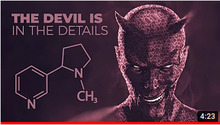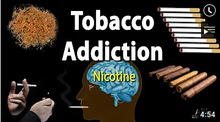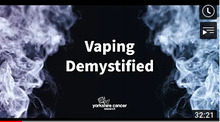| name | "nicotine addiction" |
|---|---|
| state | beta |
| class | lingo |
| category | mostly cognitive bias |
| motivation | goalposts, scope |
| science aversion | 🟥🟥🟧 |
"Tobacco control" regularly claims nicotine-only delivery systems (NVP) to be equally as addictive as tobacco. It's effectively a tobacco trivialization:

Rarely even based on junk science, typically resting on linguistic conflations. And mostly pretext to validate FUD or banning rationales.
- Some TC orgs seem genuinely unaware that nicotine isn't the sole addictive substance in tobacco. (Stuck in 80s science.)
- Seemingly also used to underpin not-quitting claims or scope creep, by exaggarating the potential on the dependence continuum.
- More plausible motivator might be confusing the habitual/prolonged NVP usage (in long-time smokers) for addiction strength.
- However when tobacco-industry conflation pairs with weasel-phrases, there's also a toll on squaring "nicotine addiction" with redeclaring NVPs as tobacco product.
Tobacco addiction amplifiers
Tobacco induces a nicotine dependency, not the other way round.
| Nicotine (+cotinine) | Still believed to be main driver (dopamine surges) |
| Acetaldehyde | Reinforcing dependence, eases blood-brain passage |
| MAOIs/Harman | Slow dopamin decay / increase serotonine(?) |
| Ammonia | Increase and speed up absorbtion in lungs |
| Tobacco alkoloids | Role not fully understood yet. (but see WTA) |
| Flavour additives | Some of which indirectly contribute to post-80s cigarettes being significantly more addictive |
| Coffeine co-dep | Is regularly ignored |
Most addiction profiles rest on intoxication strength, alacrity, and/or duration. Light stimulants like nicotine depend on side-effects.
But can nicotine be addicting on its own?
Absolutely. While dependency retention is strongest for former smokers (1% of nicotine gum users have a midterm dependency), it can still be dependence-forming for tobacco-naïve teenagers e.g. Due to lower BMI, not because of the mice brain FUD.
- Dosage is most relevant in absence of expedition. (Wouldn't factor in the nominal concentration solely however; usually self-titrated.)
- Caveat: high-nic concentrations cause quicker flooding and dissipation; with rushed use patterns contributing to higher dependence probability.
- Have to be careful with anecdotes and scripted interviews from the US. (Orchestrated by the same groups that weren't overly truthful on EVALI.)
- Keep in mind the 27% "epidemic", just 2% daily non-smokers in reality. Or the 60% overall drop 2 years later. Not much of an addictiveness quantifier, but more realistic than the hyperbole.
- Nicotine is unlikely to induce a severe dependency all by itself.
- Notably some flavour ingredients may effect MAOI-esque amplification.
- But dependency retention is fairly prevalent for former smokers. (Then again, 20 years smoking can't be fixed in 12 weeks. But explains the nirvana fallacy of ANTZ arguments.)
| nicotine use | brain-reachy | addictiveness | retention |
|---|---|---|---|
| tobacco/smoking | seconds | 🟧🟧🟧🟧🟧 | 🟧🟧🟧🟧🟧 |
| NVPs | 1-5 min | 🟧 | 🟧🟧🟧 |
| gum | 10-20 min | - | 🟧 |
| patch | 30-x min | - | - |
(Not from any specific study, just representative approximation). Patches definitely cannot be addictive, gums most likely not. And e-cigs probably not excessively higher (purely from the psychoactive POV.)
Assumption origins
- SG report on smoking (1988)
-
The report itself
was actually quite encompassing. And compares tobacco addiction to other drugs.
But essentially still attributes it as "nicotine addiction". Resulting
in media outbursts like:
The Surgeon General of the United States warned today that nicotine was as addictive as heroin and cocaine...
Albeit the report recognized aldehydes as potential contributors, it didn't "determine if these volatile smoke constituents in the doses delivered in tobacco smoke contribute to the behavioral effects of cigarette smoking". Which is why the parroting might still be the primary/subconscious rationalization for nicotine being addictive all on its own. - SG report 2010: tobacco smoke causes disease
- Intellectually quite a stepback, as it reclasses tobacco as nicotine addiction, even though references acetalaldehyes, still ignores MAOIs. Thus reinforces the assumption that nicotine was the sole addictive substance in tobacco. And although the overall report was reasonable, it devolved in PR comm.
- Tobacco industry congress hearing
-
- Intentional lying about addictiveness. Though interestingly: question was about nicotine itself, not tobacco. (Doesn't change the intent.)
- This is worth exploring, since it mirrors the same cognitive reaction as public health deluding themselves on "lights".
- And obviously corporate tobacco was quite assistive with letting the public believe that nicotine was the sole addiction driver. Maybe not the origin cause, but perhaps TC felt they achieved something by getting BigT admit to something. Only turned out to be a self-delusion; and now can't back down.
- scaremongering about NRT / nicotine gum
- * Rationales were probably similar (early 90s?). * FDA probes heart attacks in users of nicotine patch * 25 years ago how hard the anti smoking lobby fought against making NRT more freely available
- CTFK bitching about nicotine lozenges
-
Identical talking points used; see pr0408(2001).
likely to appeal to children […] candy-like […] easy to conceal. […] discourage smokers from quitting […] nicotine addiction […]. There is no evidence that this product will help smokers quit or prompt them to use other tobacco products less.
- Self-inflicted trivialization
- * Since nicotine has been instilled on smokers to be the sole addiction reason (might well improve placebo efficacy of NRT), TC fell for it themselves.
E-cigs are certainly much less addictive
- Dependence on e-cigarettes and cigarettes in a cross-sectional study of US adults
- Dependence levels in users of electronic cigarettes, nicotine gums and tobacco cigarettes
"E-cigarettes may be as or less addictive than nicotine gums, which themselves are not very addictive." - Clinical pharmacology of electronic nicotine delivery systems (ENDS): Implications for benefits and risks in the promotion of the combusted tobacco endgame
- Vaping by teens – should we be alarmed?
- Associations between nicotine knowledge and smoking cessation behaviors Nicotine hogwash deters quit attempts
- Challenging lies about nicotine addiction
- Does the content and source credibility of health and risk messages related to nicotine vaping products have an impact on harm perception and behavioural intentions?
- Nicotine has long been a victim of Zohnerisms
- "Nicotine is not addictive" (on its own)
- Harm perceptions of nicotine-containing products and associated sources of information in UK adults with and without mental ill health: A cross-sectional survey
- Fagerstrom: Dependence on tobacco and nicotine
- Communication between US physicians and patients regarding electronic cigarette use
- 🐀 Cigarette smoke extract, but not electronic cigarette aerosol extract, inhibits monoamine oxidase in vitro and produces greater acute aversive/anhedonic effects than nicotine alone on intracranial self-stimulation in rats
- "Nicotine in e-cig liquid can't be translated into cigarette equivalents."
- Editorial: The role of monoamine oxidase inhibition in smokers: Toward understanding their potential effects in reinforcing nicotine dependence
- NRT works in lieu of NVP tapering (indicatively better than for smoking/transitional use)
- dopamine, serotonin, norepinephrine (=noradrenaline), acetylcholine, gamma-aminobutyric acid, and glutamate
- Nicotine as an Addictive Substance: A Critical Examination of the Basic Concepts and Empirical Evidence (→sci-hub)
- current Jukka article collection
Important: The dependence profile is always the sum of its parts. And even though there's no reason that e-cigs would be biochemically more dependence-forming than other nicotine-only substitutes. The habitual dependency from e-cig usage can't be discounted. (Unlikely to put it anywhere near tobacco/smoking still.)


